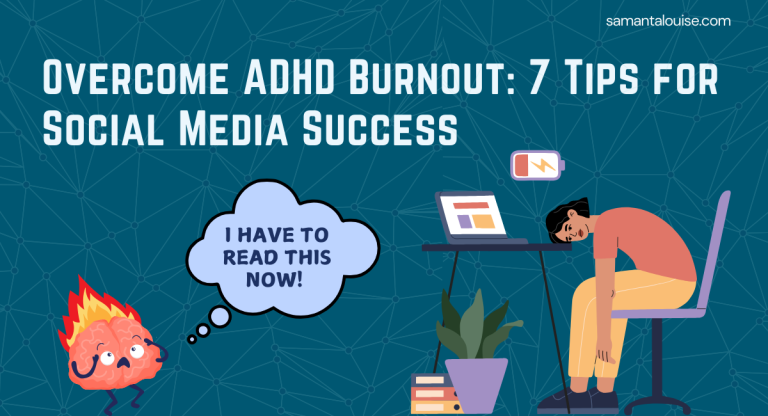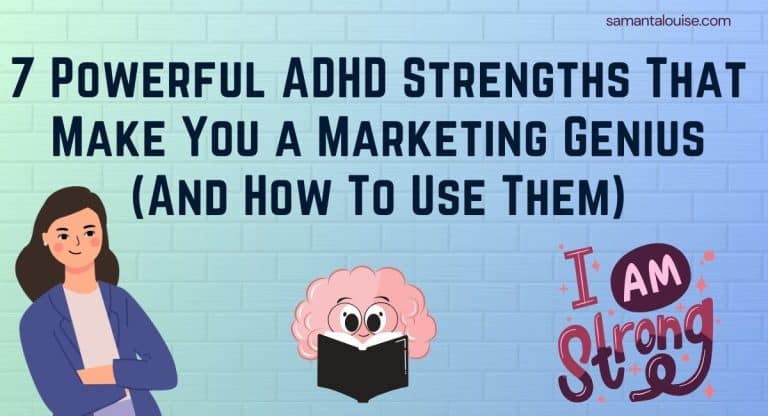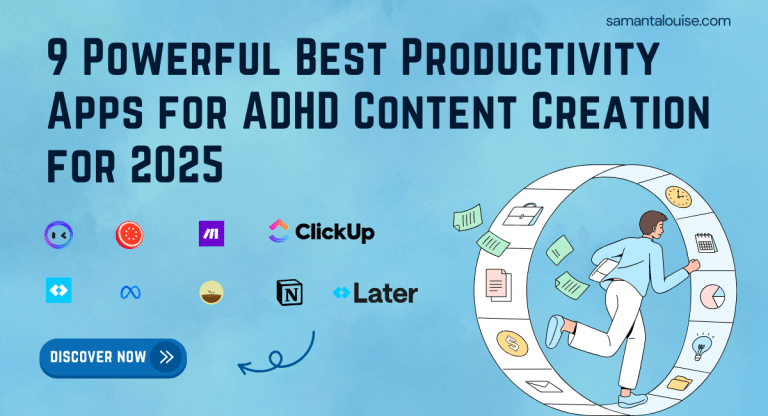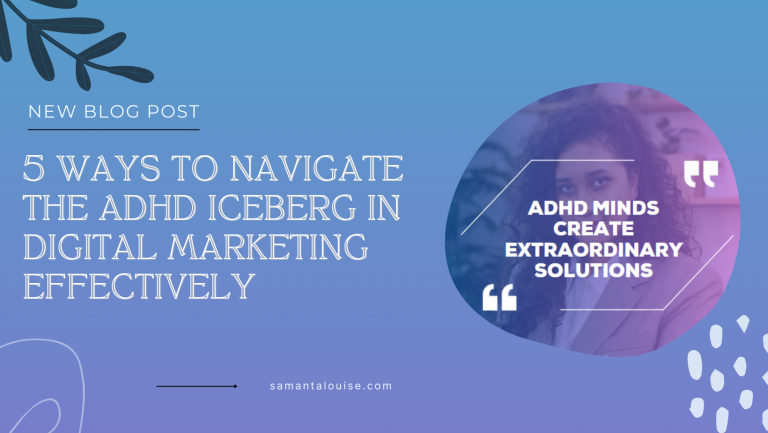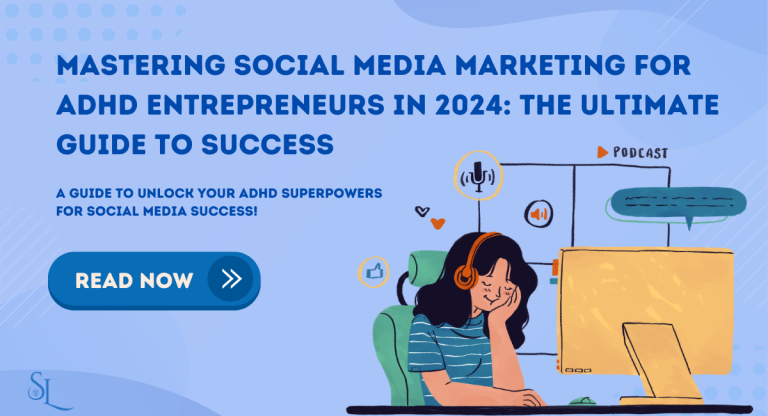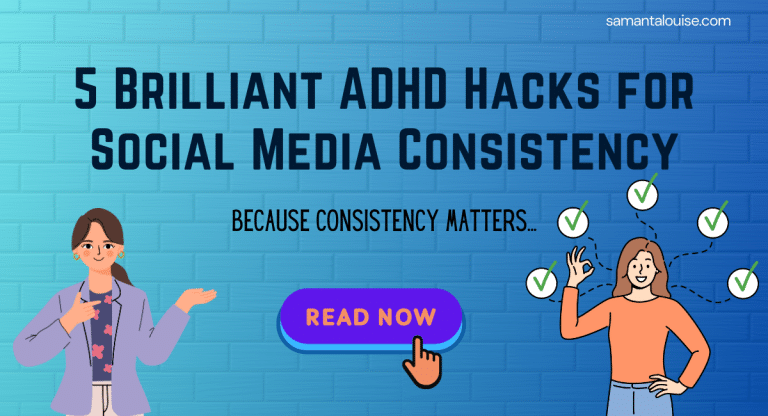5 ADHD-Friendly Social Media Content Batching Hacks for Success
If you constantly switch tasks a million times daily, social media content batching is what you need to solve this challenging endless digital marketing pitfall. Multitasking does more harm than good to our brains.
As a digital marketer with ADHD, I know how overwhelming social media marketing can feel when you are struggling to keep your focus because of the constant context-switching.
Only I know how many times I’ve given up my social media tasks just because I could not take it anymore and felt too overwhelmed and distracted to keep going.
I realised that social media marketing for ADHD digital marketers needs to be more adapted to our brains and work in our favour.
In this article, we will explore how to implement social media content batching, how it helps and five game-changing hacks to make the process ADHD-friendly.
Understanding Social Media Content Batching for the ADHD Brain
Before I discovered the content batching technique, I was surrounded by sticky notes, with 50+ browser tabs open, trying to post “consistently” on social media. My content creation strategy sucked the time, life and energy out of me.
My ADHD brain was doing its usual ping-pong routine between tasks, and I was so frustrated with the whole process of coming up with content ideas and forgetting about them the next minute. Sounds familiar?
What is social media content batching?
Content batching is a productivity technique where you create multiple pieces of content in a single, focused work session, rather than producing content daily or randomly. It’s the strategic process of grouping similar content creation tasks together to maximize focus, minimize context switching, and maintain consistent content delivery.
Think of social media content batching like cooking meal prep on Sunday for the whole week. Instead of making each post daily, you create multiple posts in one focused session.
Of all the content creation methods I used, social media content batching turned out to be the most effective one for my ADHD brain. Here’s why it works so well for our ADHD brain: Every time we switch tasks, it gives us an opportunity to be distracted or lose focus.
Each time I tried to create content on the fly, it would lead to one result: inconsistency. I just felt exhausted and distracted to follow through with my tasks. And here’s another reason why it worked: I was no longer worried about low-motivation and low-energy days as I’d already created content in advance scheduled and ready to post.
Batch creation helps reduce our cognitive load, and instead of deciding what to post every single day, you make all those decisions in one focused session. It gives us more creative freedom. When you are not scrambling to post something at the last minute, your brain has space to come up with genuinely creative ideas.
Hacks That Will Revolutionize Your Social Media Content Batching Process
Let’s go directly into the ADHD-friendly social media content batching hacks that transformed my social media marketing journey into a more pleasant and productive experience.
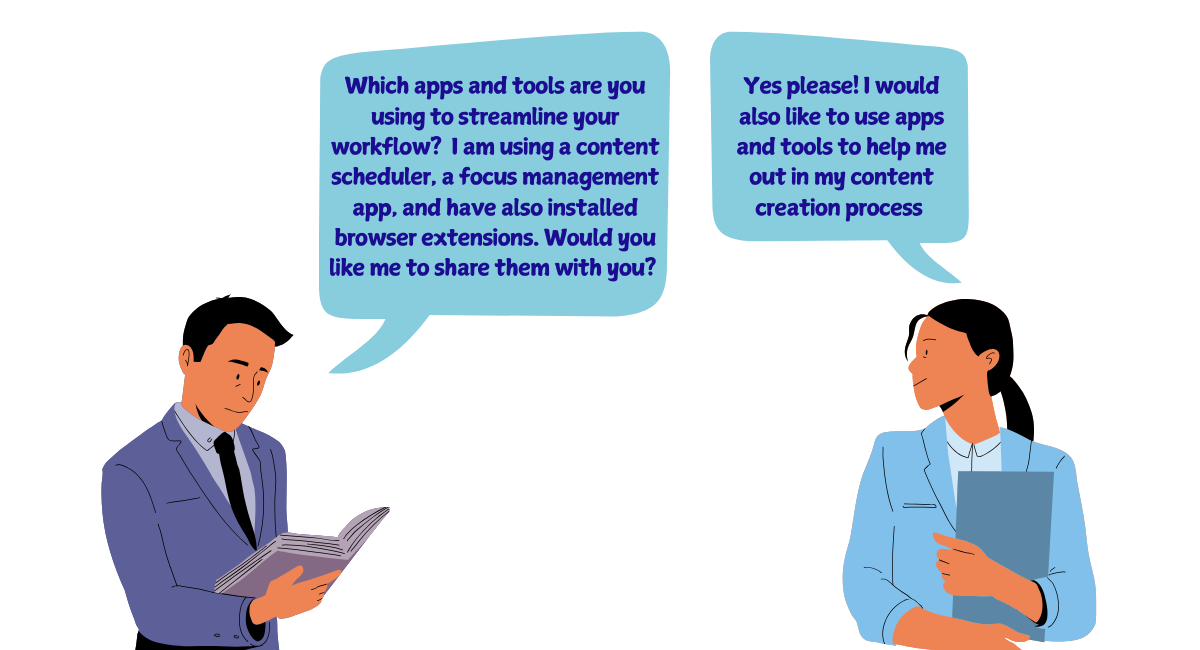
Hack 1: Use Tools and Apps to Improve Your Workflow
After years of scattered social media management attempts, I’ve learned that the right tools and apps aren’t just helpful, they are essential for those of us with ADHD brains. And this is not an attempt to sell you anything as most of these tools are free.
Let me share a personal anecdote. Last year, I was using five different apps to manage my content, had notes scattered across three devices, and kept missing posts because I could not remember which content scheduling tools had what. It was a classic case of ADHD workflow optimisation GONE WRONG.
Back to the present, I use only one app for content scheduling: Later. From one place, I can create, schedule and publish content across multiple social media platforms. I use Notion to generate and develop content ideas.
This is a simple content management system that has worked wonders for me. When I create my content in bulk, I have two main tabs open: Notion and Later. This single decision reduced my task management ADHD stress by a lot.
Another essential tool is a focus management app that is easily available for free online. I love using Focus ToDo and Forest. They help me stay focused during my batch working sessions with an interactive Pomodoro Timer. Regular music can be too distracting, and silence makes my thoughts too loud, so I use the white noise available in the Focus ToDo app.
Here’s a crucial tip for content creation systems: install browser extensions that let you save content ideas instantly. I use the Save to Notion extension, which lets me capture inspiration with one click.
The final piece of my productivity system was creating one central hub where everything lives. This means integrating my scheduling tool, idea bank and content drafts into one ecosystem. You can do this on Notion, Excel or Google Spreadsheets.
The aim is to have everything in one place so that you do not have to switch constantly. You can set up automation on Make to help you do this without adding more to your workflow.
Hack 2: Use Timeblocking Techniques To Ensure You Respect Your Social Media Content Batching Time
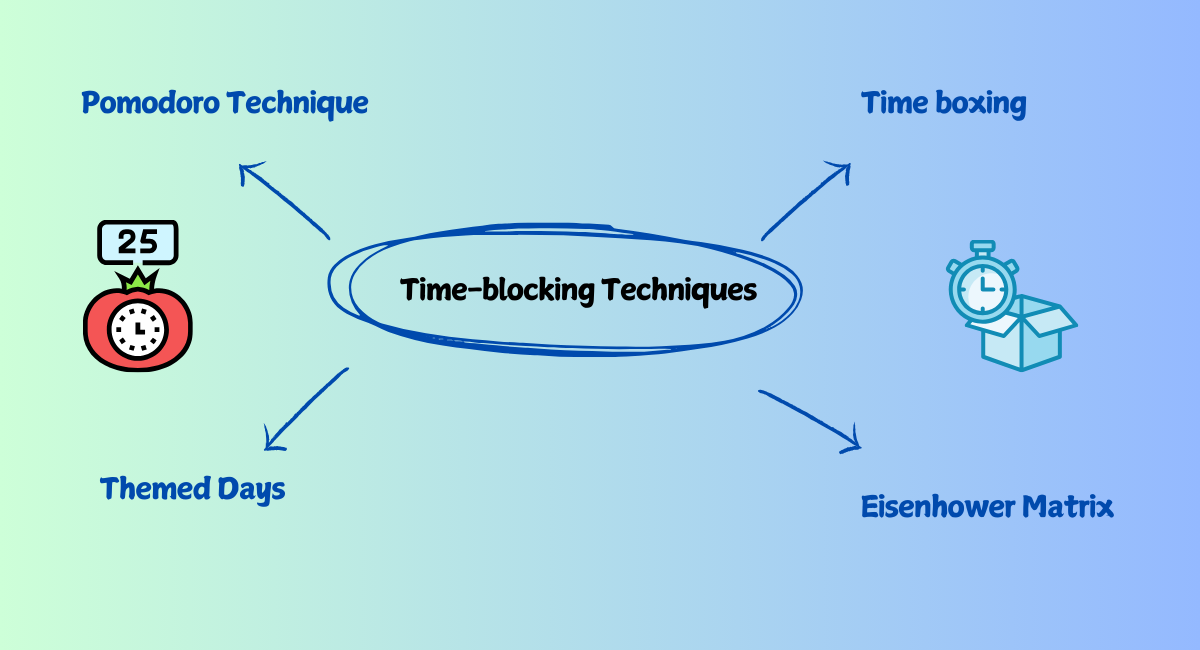
Social media content batching sounds great until you actually have to sit down and do the work without being distracted and bored with the tasks… Time management is extremely challenging for individuals with ADHD but with the right strategies, you can revolutionise your ADHD time management.
Time-blocking involves dividing your day and week into specific blocks of time, each dedicated to accomplishing a particular task or group of tasks. Specific techniques can make time-blocking more effective during social media content batching.
The Pomodoro Technique is a great method to time yourself when working. You can set working periods of 25 minutes and take 5-minute breaks in between. Focus To-Do is a Pomodoro timer app that works well.
Time Boxing is an effective method of allocating a fixed period of time to a specific activity. For example, I know that it takes me around 20 minutes to come up with a content idea for an educational photo post on Facebook, create the photo on Canva, write the caption and schedule it. This method will ensure you do not exceed the time allotted for a content batching session.
You can use the Eisenhower Matrix to prioritise your most important content creation task. It is a matrix that is divided into four quadrants: Neither urgent nor Important, Urgent and Important, Important, but Not Urgent and Urgent but Not Important. After analysing where your social media tasks fall into the quadrant, you can choose to do these tasks first, schedule the tasks for later, and delegate or eliminate them entirely.
You should not forget to leave buffer zones between your time blocks so that you can account for any delays. Let’s say you allocate three hours for content ideas generation and 2 hours for video editing, leave a buffer zone of at least 30 minutes in between. They serve as a breathing room for our unpredictable ADHD minds and time blindness.
You can set up themed days for your social media content batching to make the work less boring. For example, you can dedicate Mondays for Instagram Reels and Threads posts (One video-based and one text-based to spread the level of effort needed) and then dedicate less busy days for more complex content creation work.
Finally, you can stack similar tasks together like building blocks. For instance:
- Block 1: Write all social captions
- Block 2: Create all images
- Block 3: Schedule everything
This social media efficiency approach works because it minimizes context switching—the kryptonite of ADHD work strategies. These tricks to improve your executive functions are specifically handy when planning content for a whole month.
You can read my full article on these time-blocking techniques, in which I explain how to use and implement each one.
Hack 3: Use Templates and SOPs to Guide Your Workflow and Help You Reach Your Goals
Ever stared at a blank screen for 45 minutes trying to write a simple Instagram caption? Been there… That’s why I created my own Quick-Content Launch System for content creation management. It is like having a preset menu for your social media strategy and one of the best tools and tricks to improve your content marketing strategy.
It consists of creating templates and SOPs to streamline the whole process. Here’s how I do it:
- Create fill-in-the-blank templates for your posts
- Story posts: “Today I discovered ___ while ___. Here’s what this means for ___”
- Tips posts: “Want to ___ without ___? Here’s my top 3 ways: [1. ___] [2. ___] [3. ___]”
- Behind-the-scenes: “Currently: ___ While: ___ Because: ___”
- Create a content-type library for each category of content
- Educational content (teach something)
- Personal story (Share your story) – create a personal story bank in a Notion folder
- Promotional content (Offer value)
- Create Standard Operating Procedures (SOPs) to act as a guide for your actions
- It’s a step-by-step guide that shows exactly how to complete a specific task the same way every time
- Start by writing a list of actions you do during a specific task
- Write down the main steps you are taking to complete the task
- Be specific with the steps you note down
- Use bullet points, not paragraphs
- Once written down, always follow the list of steps (Basically a checklist)
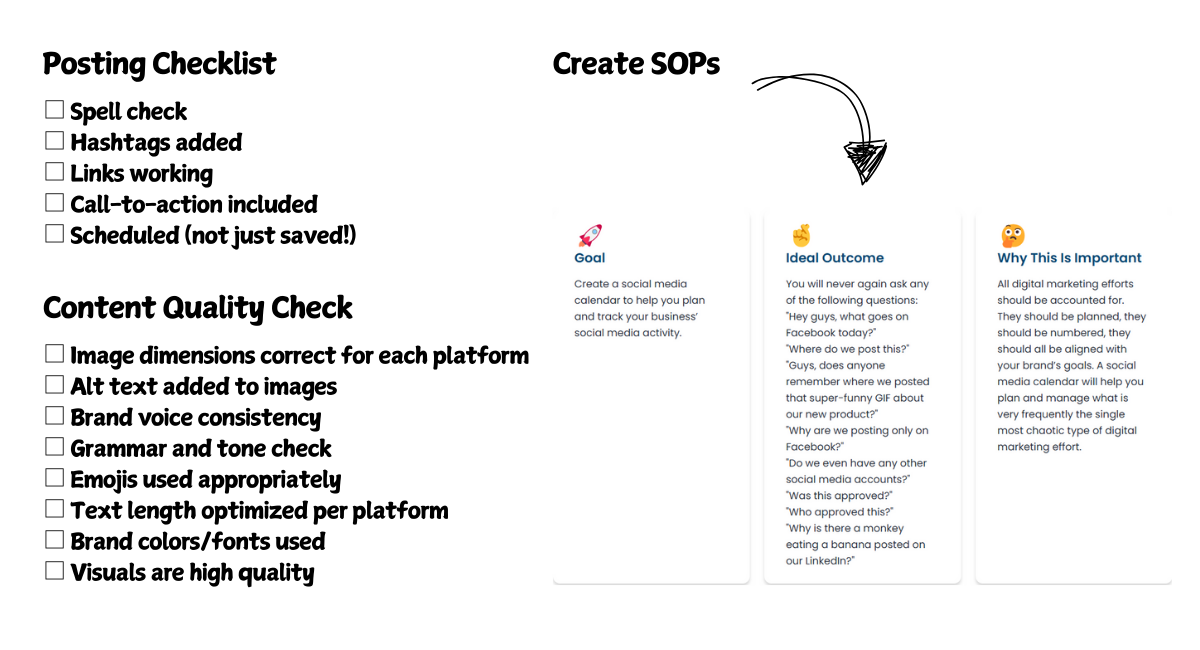
Keep these templates in ONE place. I use Notion, but even a Google Doc works. The key is having a single source of truth for your content creation system. The key is having a single source of truth for your content creation system.
For visual content creation, I use Later’s content scheduler. I can view my posts as they will appear on my chosen social media platforms. This eliminates the “but what should it look like?” paralysis that usually kills our productivity techniques’ effectiveness.
This entire social media efficiency system might seem like a lot upfront, but it’s actually the ultimate ADHD work strategy—set it up once, benefit forever. No more reinventing the wheel every time you need to post!
Hack 4: Optimise Your Work Environment To Turn It Into Your Focus Zone
Your environment shapes your ADHD work strategies more than you think. I tried to create content whilst sitting on my bed with the TV playing in the background but each time, I ended up not finishing the work I started. There are some hacks you can use to make your environment a working space that encourages you to start and finish your work. Let’s explore each one of them below.
First up: body doubling. It is an effective ADHD productivity technique which enhances motivation. I came across this focus management technique when I was in high school. I did not know yet that I had ADHD but realised it helped a lot. Think of it as having a homework buddy but for work. As soon as you start your social media content batching process, turn on a live Youtube video of someone working or find a friend to work with.
Basically, you need to have someone working side by side with you even if you are not doing the same thing. Nowadays, it is easier to do this with Youtubers going live and working on camera though I think it is most effective when you have someone physically working with you who is acting like an accountability partner without the pressure of conversation.
Your content creation workspace needs to be like a cockpit – everything within reach, nothing extra. Adopt a minimalist strategy. Here’s my non-negotiable setup:
- Dedicated desk (not the kitchen table!)
- Essential tools only
- No visible distractions like Nintendo (seriously, hide it)
- Water bottle (because thirst suddenly becomes urgent when focusing)
You can use noise-cancelling headphones to neutralize any distracting sound or play some white noise to remain focused. I use them with some white noise for optimal task management ADHD support.
Setting up a dual-screen setup was a superb and positive transition for me. It made my content creation workflow so much easier. I use my bigger screen (monitor) to create content and my main screen (laptop) to view reference materials and templates, and seek inspiration. This prevents the tab-switching chaos that destroys our executive function abilities.
Always remember your environment either works for or against your focus techniques. Make it work for you.
Hack 5: Gamify Your Social Media Content Batching Process and Implement A Reward System
Let’s be honest – our ADHD brains are basically dopamine-seeking beasts. Instead of fighting this, I’ve turned my content creation workflow into a game that stimulates my brain. So, each time I start a new batch of content, I gamify the process and make it fun for me to follow through.
Habitica helps me a lot with the gamification of my tasks. It is essentially a routine building app that encourages its users to remain consistent by turning their real life into a game experience. With this app, I can create avatars and use RPG (Role-Playing Game) elements to gamify my social media tasks.
My SOPs and checklists serve as a good basis for Habitica. I can insert the tasks into Habitica to track my streak and earn points. My avatar in Habitica can accumulate points as I complete my social media content batching process.
Another game-changing hack is implementing a reward system to motivate you. Each time I finish a batch of content for a specific platform, I reward myself with something I love to do, for example, watching an episode of my favourite Mandarin show or eating a nice pudding. The choice of rewards is endless.
Here are my usual Quick-Win Rewards for completing tasks:
- 3 posts scheduled = 5-minute TikTok break
- Week of consistent posting = favorite coffee order
- Monthly content calendar completed = online course or tool you’ve been eyeing
Use visual progress trackers. I keep a simple progress bar on my desktop (using Notion’s progress bar) showing:
- Daily task achievements
- Monthly content goals
- Weekly post completion
The secret to making this reward system stick? Make the rewards exciting. The more difficult the tasks are, the more satisfying the rewards should be to increase motivation.
- Small rewards: Favorite snacks, short game breaks
- Medium rewards: New content creation tools
- Big rewards: Courses, tech upgrades
Maintaining Momentum: How to Make Social Media Content Batching a Sustainable Habit
Here’s the thing about social media content batching with ADHD: it’s not about being perfect; it’s about being consistent-ish. After years of trial and error (and let’s be honest, mostly error), I’ve figured out some stuff that actually sticks. I have shared all of my hacks with you and hope that you can make the most out of it.
Here are a few tips to make these hacks work for you and not against you:
- Start with one hack at a time: Do not try to implement all of these hacks all at once, you will fail miserably due to overwhelm
- Be realistic: Do not set expectations of yourself that cannot be achieved. If you have a 9-5 and you are managing content as a side hustle, you will need to adjust accordingly.
- Be forgiving with yourself: Do not expect perfection right off the start. There will be times you will falter but that does not mean you failed altogether.
- Be flexible: Pay attention to what works and double up on that instead of being rigid with hacks that are not working.
- Use AI tools to speed things up: My favourite AI tool is Monica AI which helps me to write my content faster by adopting my writing style and following my templates.
Summing up
The key to making this work for ADHD minds is understanding that it’s not about rigid systems or perfect execution. It’s about creating dopamine-friendly planning sessions that sense for your brain. I have seen countless ADHD social media strategies fail because they try to force neurotypical solutions onto ADHD minds but it is time we do what’s best for us.
You can check out my article on the best social media tools for ADHD social media marketers if you want to know which tools I use to streamline everything, and the best news is that most of these tools are free or offer freemium versions to users.
If you want to have free social media marketing resources delivered to your email every month with tutorials and tips, subscribe to my Newsletter.

